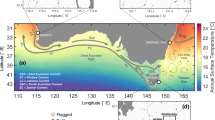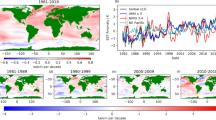Abstract
In order to study the temporal variations of correlations between two time series, a running correlation coefficient (RCC) could be used. An RCC is calculated for a given time window, and the window is then moved sequentially through time. The current calculation method for RCCs is based on the general definition of the Pearson product-moment correlation coefficient, calculated with the data within the time window, which we call the local running correlation coefficient (LRCC). The LRCC is calculated via the two anomalies corresponding to the two local means, meanwhile, the local means also vary. It is cleared up that the LRCC reflects only the correlation between the two anomalies within the time window but fails to exhibit the contributions of the two varying means. To address this problem, two unchanged means obtained from all available data are adopted to calculate an RCC, which is called the synthetic running correlation coefficient (SRCC). When the anomaly variations are dominant, the two RCCs are similar. However, when the variations of the means are dominant, the difference between the two RCCs becomes obvious. The SRCC reflects the correlations of both the anomaly variations and the variations of the means. Therefore, the SRCCs from different time points are intercomparable. A criterion for the superiority of the RCC algorithm is that the average value of the RCC should be close to the global correlation coefficient calculated using all data. The SRCC always meets this criterion, while the LRCC sometimes fails. Therefore, the SRCC is better than the LRCC for running correlations. We suggest using the SRCC to calculate the RCCs.
Similar content being viewed by others
References
Chen, G. S., Wang, Y. M., Liu, D. F., and Liu, S. Y., 2016. Detection of basin runoff variation based on moving correlation coefficient method. Journal of Natural Disasters, 25 (1): 11–18.
Cooper, P. I., 1969. The absorption of radiation in solar stills. Solar Energy, 12 (3): 333–346.
Elias, A. G., and Zossi de Artigas, M., 2003. A search for an association between the equatorial stratospheric QBO and solar UV irradiance. Geophysical Research Letters, 30 (16): 337–356.
Galton, F., 1888. Corelations and their measurement, chiefly from anthropometric data. Proceedings of the Royal Society of London, 45: 135–145.
Ji, X. P., and Zhao, J. P., 2015. Analysis of correlation between sea ice concentration and cloudiness in the central Arctic. Haiyang Xuebao, 37 (11): 92–104 (in Chinese with English abstract)
Kodera, K., 1993. Quasi-decadal modulation of the influence of the equatorial quasi-biennial oscillation on the north polar stratospheric temperatures. Journal of Geophysical Research Atmospheres, 98 (D4): 7245–7250.
Maurer, C., Koch, E., Hammerl, C., Hammerl, T., and Pokorny, E., 2009. BACCHUS temperature reconstruction for the period 16th to 18th centuries from Viennese and Klosterneuburg grape harvest dates. Journal of Geophysical Research Atmospheres, 114 (D22): D22106.
Pearson, E. S., 1938. Karl Pearson: An appreciation of some aspects of his life and work. Biometrika, 28 (3-4): 193–257.
Pearson, K., 1896. Mathematical contributions to the theory of evolution. –On a form of spurious correlation which may arise when indices are used in the measurement of organs. Proceedings of the Royal Society of London, 60 (3): 489–498.
Salby, M., Callaghan, P., and Shea, D., 1997. Interdependence of the tropical and extratropical QBO: Relationship to the solar cycle versus a biennial oscillation in the stratosphere. Journal of Geophysical Research, 102 (D25): 29789–29798.
Schmid, J., 1947. The relationship between the coefficient of correlation and the angle included between regression lines. Journal of Educational Research, 41 (4): 311–313.
Soukharev, B., 1997. The sunspot cycle, the QBO, and the total ozone over northeastern Europe: A connection through the dynamics of stratospheric circulation. Annales Geophysicae, 15 (12): 1595–1603.
Varotsou, E., Jochumsen, K., Serra, N., Kieke, D., and Schneider, L., 2015. Interannual transport variability of upper Labrador Sea water at Flemish Cap. Journal of Geophysical Research Oceans, 120 (7): 5074–5089.
Zhao, J. P., and Jie, S. U., 2004. Causes for correlation and inconsistency between two kinds of low-frequent signals. Periodical of Ocean University of China, 34 (5): 697–703 (in Chinese with English abstract).
Zhao, J. P., Barber, D., Zhang, S. G., Yang, Q. H., Wang, X. Y., and Xie, H. J., 2018. Record low sea ice concentration in the central Arctic during summer of 2010. Advances in Atmospheric Sciences, 35 (1): 104–113, DOI: https://doi.org/10.1007/s00376-017-7066-6
Zhao, J. P., Cao, Y., and Shi, J., 2006. Core region of Arctic oscillation and the main atmospheric events impact on the Arctic. Geophysical Research Letters, 33 (22): L22708.
Acknowledgements
This study is supported by the Key Program of the National Natural Science Foundation of China (No. 41330960) and the Global Change Research Program of China (No. 2015CB953900). We are thankful to Dr. Yanyue Shi for her helpful suggestions.
Author information
Authors and Affiliations
Corresponding authors
Rights and permissions
About this article
Cite this article
Zhao, J., Cao, Y. & Wang, X. The Physical Significance of the Synthetic Running Correlation Coefficient and Its Applications in Oceanic and Atmospheric Studies. J. Ocean Univ. China 17, 451–460 (2018). https://doi.org/10.1007/s11802-018-3798-x
Received:
Revised:
Accepted:
Published:
Issue Date:
DOI: https://doi.org/10.1007/s11802-018-3798-x




